Threesology Research Journal
The Devil's Advocate and 3's Research
~ 8 ~
~ The Study of Threes ~
http://threesology.org

Researchers as of 8/29/2019
In my quest to acquire some— even approximate understanding of the "Threes Phenomena", one can not help to bemused by reflections suggesting
a more comical note to such an enduring practice. For example, one might perceive a hunt for threes in terms of a
Don Quixote type of pursuit involving some formula of a three-character ensemble
such as 1) Don Quixote 2) squire Pancho and 3) the noble steed Rocinante, which can alternatively be described as a Quixotic entrainment. Yet, if we
look at the story, it reveals the literary model of a cognitive mapping scheme many of us identify with:
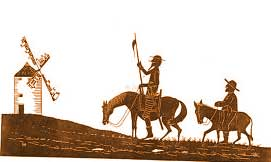
The thematic richness of the novel is such that it's inexhaustible; it's a spectacular recreation of the world during Cervantes's time. The
main topic is the possibility of finding the ideal in the real, and it's entwined with the ethical concept of human freedom: Can we change the
world or will the world change us? Is it morally acceptable, changing the world? Other themes stem from this one:
- Literary archetype: The literary critic is a constant in all of the Quixote, especially against the knight tales, the theatre of Lope
de Vega and the pastoral novels.
- Love archetype: The main couple (Don Quixote and Dulcinea) aren't really together, so there are other love stories, mainly among
younger people. Jealousy is also a topic, a very important one in all of Cervantes's works.
- Political archetype: An utopian archetype of politics, like when Sancho decides he wants to be Governor of an island.
The Greatest Books of the Spanish Empire and the
XXIst Century |
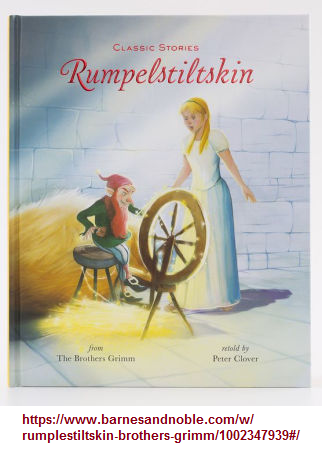
Some readers do not realize is that the above remarks, like so many literary analysis, is a type of drawn-out blueprint... a map so-to-speak.
However, if my pursuit of the "Threes phenomena" is not viewed in terms of a type of literary or artistic expression (though the
Threes posters are both a manuscript and canvas); with respect to defining one or
multiple 3-character ensembles from different subject areas... then quite possibly one might interpret my efforts in terms of a "three-tasks
to-be-performed" formulation such as seen in fairytales (for example, the young woman is provided three attempts to guess the name of
Rumpelstiltskin).
There are of course other fairy tales, counting games, and short refrains that do not have elaborately portrayed themes and character development
scenarios, but some tales, such as in one variation of the Childe Roland story... he is told to travel to the third bend in the road by an old woman;
while other variations of Childe Rowland describes two brothers, implies three
sections of the Earth (by describing a middle earth) and divulges the usage of a tactic of turning 3 times around in a counter-clockwise
(widdershins) fashion.
A momentary reflection on the topic of "middle earth" is opportuned at this moment to reflect on the "three earths" idea developed as
The Nine Worlds of Norse mythology associated with the three-rooted
yggdrasil tree. The nine can thus be interpreted as an imaginative "larger than life"
portrayal idealized by those whose interpretation of unknowns fancifully created a reflection of suppositions, fears, superstitions, and
mentally scraped-out doodlings:
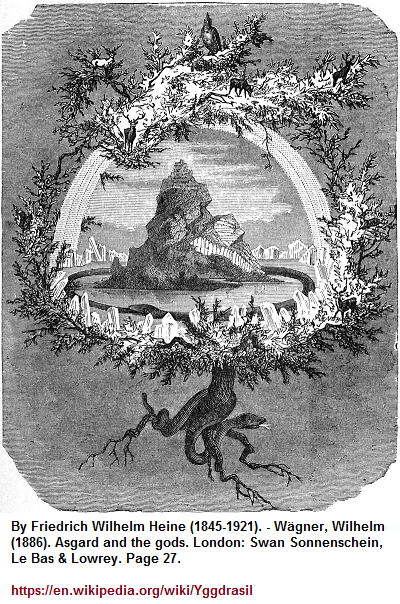
The Norsemen visualized the universe in three vertical levels; a tricentric structure. Between each level and its adjacent level was a space.
The axis of the three levels and nine worlds was the Yggdrasill tree, a mighty ash which is timeless, has no origin and will survive Ragnarok.
The first level
- Asgard, world of the Aesir
- Vanaheim, land of the Vanir
- Alfheim, land of the light elves.
The second level
- Midgard, Land of humans (middle world/garden)
- Nidavellir, Land of the dwarfs
- Jotunheim, Land of the giants (Jotuns)
- Svartalfheim, Land of the dark elves.
The third level
- Hel, Realm of the dead
- Niflheim, World of the dead.
If Hel and Niflheim comprised one world, as is suggested in some sources, the ninth may have been Muspelheim (Muspell), the land of the fire giants. This
region had no place in the tricentric structure of the universe, and Snorri Sturluson wrote that is was the first world to exist and that is lies in the
southern hemisphere. Also, the worlds of Svartalfheim and Nidavellir may have been the same. No valid distinction can be drawn between the dwarfs and dark
elves; they appear to have been interchangeable.
The Norse Gods
|
Then again, from fairytales and folk-tales we necessarily come to describe myths and legends which take on a modern life of there own by being
perpetuated into expressions of inter-generational history in various forms such as stage plays and motion pictures like, the more involved tale of
Jack and the Beanstalk having three, five or more magic seeds/beans leading to
the acquisition of a golden harp, bags of coins and a goose who lays golden eggs. (Some versions of the tale don't ascribe any identifying quantity
to the beans.) Another three-laden tale which has modern forms of offspring renditions is found in the tale of
Jason and the Argonauts as described below:

My pursuit of the Threes Phenomena might be viewed along the lines of attempting to discover some proverbial
Golden Fleece, which could only be acquired after completing
three tasks:
- Jason's first task was to plow a field from end to end using the Khalkotauroi, two fire-breathing bronze-hooved bulls which would burn him
without some protective ointment that we of today might refer to as sunscreen.
- Jason's second task was to sow dragon's teeth in the plowed field.
- Jason's third task was to vanquish the army of stone warriors springing out from the earth from the planted dragon's teeth.
Jason and the Argonauts encountered various gods and monsters on their epic voyage, some of
which were described in a three-patterned profile (and might involve others if the tale was read with a "threes" search in mind):
- The Harpies, who, like the 3 Furies, were employed by the gods as
instruments for the punishment of the guilty, were three female divinities, daughters of Thaumas and Electra, called Aello, Ocypete, and Celæno.
- The test of the fire-breathing bulls is one of three Jason must complete to win the Golden Fleece, and yet it is one that has
received the least scholarly attention.
- The motif of the Spartoi appears in two Greek myths, that of Jason and that of Kadmos. The Greeks explained this coincidence by
suggesting that after Kadmos killed Ares' dragon, the dragon's teeth were divided, with half going to Kadmos and half to Aeetes, who later forced
Jason to sow them in one of the three tests Jason needed to complete to win the Golden Fleece.
- Jason has to defeat the ever-watchful serpent guarding the tree in which the Golden Fleece hangs. (Hence, if this is another task besides those
three previously described, it may be counted by some as "4" tasks instead of as an alternative version of the tale.)
Jason and the Argonauts through the Ages: Gods and Demons |
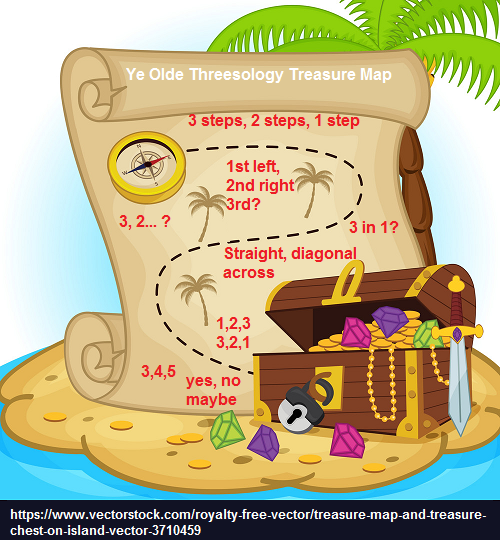
Yet, if not the travails of Don Quixote, or the quest for a golden fleece, then the reader might interpret my pursuit of the Threes
Phenomena as the search of a Holy Grail or even some fabled
lost treasure, of which there are many stories. Unfortunately, I am not as
romantically inclined as any of these stories may suggest (since quite often there is some women involved who is the target of someone's affections
and my days of writing love poetry have come and gone). Nonetheless the idea of having an old treasure map stirs the fires of imagination of the
young child within me. Alas... then again perhaps fortunately... since I have no ready-made map nor can I purchase a mock-up that I might chance
upon while exploring some back alley venue of an exotic bazaar harboring a host of black market antiquities dealers who might think to cunningly
pawn one off on me as being authentic. Thus, I am left with little choice but to draw up such a map myself, in the form of a timeline.
At this point, if it is not already obvious to those who do their own variations of research both online and offline, there is no readily
available manuscript nor text from which might be culled your desired ideal representation of your idea(s). Like an artist working with a blank
canvas, depending on the level of "noviciary" (noviceness) one has at a given time and place, you may or may not begin with a basic sketch that
follows someone else's rule-of-thumb for creating that which you tell yourself or assumed with an unvoiced inclination. For example, in writing a
poem you might research someone's teaching methodology or simply read poetry and construct one that is similar to the style and content of that
which has been read. Otherwise, you will ultimately have to create your own as a reflection of the way you see things as an individual, be it with
rhyme, free verse, prose, or otherwise... and attach an original or already made up style to reference it.
While there may this or that source which provides what at first glance appears to be the exact information you are looking for to be used for
something you are either definitively looking for or are simply in touch with an unarmed hint, shadow, calling, spectre, allusion, etc., that which
is found (and may not be exactly what you are looking for or think you are searching for); is a finding that may later be noted as but a small
variation of that which you are individually pursuing... even if it is not explicitly labeled or defined. Original ideas often involve original
(i.e. individualized) formulas of research, explanation and expression.
You are a unique person. We are all unique in our individual way. Yes, there are those with similarities, but no one is exactly like you. Those
who learn how to develop their uniqueness move beyond the normal trek of mediocrity. While for some this path is easy, others have had to suffer and
struggle against those impulses to copy others in dress, manner, feeling and thought. For some, they are frightened and emotionally distressed upon
encountering no one who appears to be like them. Yet still others are welcomed by such a realization of being different. They relish their
differences to the point of exploiting them in creating a person whose uniqueness is socially established as a talent, or giftedness, or even genius.
For those that don't, they are an expressed representation of those who follow the status quo and will not forage the necessary path of individually
that is best for them, despite all those who want them to be a reflection of their sameness. Far too many fear the unknowns of their truly unique
selves which may have no available social application in the time period to which they were born. Your uniqueness may be better suited for a future
age, just as when we encounter someone from the distant past whose ideas were far ahead of their time, and they pursued them within the context of
a lifestyle conducive to the time period in which they inhabited. Otherwise, life can be full of hardship if their uniqueness is so far out of step
with the currency of normalcy, they come into conflict with it to the point of being ostracized, financially or otherwise.
It is a given for those who are inclined towards a genuine sense of personalized uniqueness, that you may find no one who thinks exactly like you
in the given time and place of a research effort (and not that this means there is no one who does— existing somewhere in the world); which
requires you to piece together information from a variety of sources. While some view such an effort as an adventure of discovery, others simply
hate having to explore... a difference between primates who prefer to have fruit nearby the limbs the sit on and those who come to seek that which
may lay beyond the boundaries of the known forest and jungle. Humanity took the latter trek... though most humans appear to prefer to sit on a
territorially marked out limb in a state of socially created formula of inter-active dependency which we are all forced to occupy at one time or
another.
There is no online nor offline encyclopedia or dictionary for those doing original/creative research. If such texts existed, then their work
would not be original. They would simply need to copy the information as it is laid out in the manner it is presented and sign their name to it.
As such, when creating an offline or online journal such as the Threesology Research Journal, its compilations may give the impression of a
scattered accumulation of bits and pieces with no logical construction or definitive orientation other than collecting various models of
three-patterned ideas illustrated in one way, another way, or multiple ways. Yet, this is how the information is being found. The entire internet is
not an alphabetic nor enumerated list of information for those whose ideas may take years to develop and produce some representative sample of what
they are pursuing... even if the produced image seems a rather simple illustration that anyone can have produced... but no one did. The in-ternet
and off-net (library book shelves, etc...) are gatherings and presentations of this bits-and-pieces assortment of varied information, representing
this, that and other variations of ideas coming from millions of sources. It is schizophrenic, bipolaric, depression, Euphoria, regression, psychotic,
socio-pathic, etc... in its content and organizational methodology that we call normalcy because a majority of people use it and have come to rely on
it in the way it is compiled and being offered... with one rationalized business model followed after by another philosophical inclination, in its
compilation and presentation to the public.
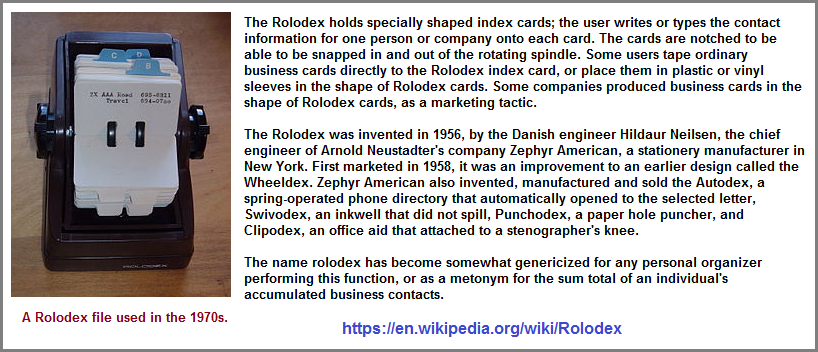
There is no roladex for those pursuing information for the production of an original idea, despite the best attempts to create one by Google
Chrome, Opera, Safari, Mozilla Firefox, MSN's IE, OmniWeb, iCab, Konqueror, Epiphany and the many other
web browsing search engines used in different environments with different types of
computer platforms. If there was a rolodex, we would need only one world-wide search engine because it would be able to supply everything in an
orderly fashion for all variations of human cognition; thereby separating the many genres of interest into their own respective internet realms and
not lumped together and creating so much nonsense and confusion as does the current hodge-podge of business, religious, political and journalistic
inter-lopings do. As such, in the current atmosphere, it is like going to a library and finding all the different genres of books, pictures, sound
recordings, etc., piled together and you must adopt your own search techniques... good or bad, towards finding information useful for whatever it
is you are currently focused on... and then you must develop your own means of arranging the material unless you use someone else's preference.
Just because information is presented in printed matter, as opposed to remaining in a "word-of-mouth" state, does not mean it is automatically
supposed to be interpreted as factual or of any value for your particular interests. Even so-called serious books of information by so-called experts
can not be relied upon to provide you with the type or format of information you need for your particular orientation of producing an original idea,
though you may cull bits and pieces of information from them. For example, take any textbook and you will see a presentation of what the author or
authors think is best to present a selection of material that the reader... often a student, should... needs to... or must... learn in a given
order in order to provide some academic required level of competency; thus providing them a means to provide a graded score that a given type and
means of learning has taken place... which you or the taxpayers are charged for.
The information in a given text is a sequence some author or book publisher made up and may not themselves have been subjected to in getting to
the time and place (professorial/business position) that their perspective now inhabits. They create a step-wise list of information they think is
the best way for the majority or some presumed average student or citizen can learn, thus creating a source that can be used to teach (and sell) in
order to make a living from as a supplement to an established salary. However, the information in the sequence they lay out may not be what is best
for you, nor thousands of people wanting to get some knowledge of a given subject... a subject which may cover multiple subjects that one or more
of the authors of a given book may or may not be that knowledgeable of... or if they are the foremost expert in a given field, may not be
particularly good in instructing the information to others. Many a professor I have listened to have no real sense of the education process, but
are given an allowance for their teaching inadequacies because of some published notoriety and/or award given to them quite often by others who are
not particularly adept at teaching either. (The same condition occurs in the political, business, theological fields, where... for example, the U.S.
Congress is filled with incompetent leaders supported by incompetent journalists and a stock market who views competency in whomever helps them make
a buck. It is actually a sad stare of affairs when one thinks of wanting progressive development.)
In the development of many, many, many original ideas and follow-up productions, products, crafts, diagrams, models, sculptures, paintings,
architectural drafts, etc., there are no textbooks, no manuscripts, no brochures, no blueprints, no scripts, no recipes, no definitive nor
sketched or doodled guidelines for a person to follow. While you may take large swaths of information for a given portion of the to-be
representation you have begun to formulate in your mind; more often the accumulation of material is derived from sources providing piece-meal...
bits and pieces, that may or may not be clearly illustrative in the setting to which they are found. Like a one-person or multi-person research
and development team, you may be on your own— attempting to develop that which has never been developed before. A good example of this is
the development of the atomic bomb by way of
The Manhattan Project. However,
historical re-tellings (like the noted Winston Churchill expression that History is
written by the Victors), do not always tell of the many detours, stumblings, accidents, and erroneous as well as fruitful paths which really
occurred, because all of them were not counted... much less re-counted later on. As with many of us, obstacles are simply brushed aside and we move
on, without taking the time to record every single instance of delay or interruption... though break- throughs may be over-emphasized and embellished
to fit within the scope of a particular person's egoist e-valution thereof. Nonetheless, the story of the Atomic Bomb's development "from scratch",
so to speak, is a good analogy to be proposed as a means of addressing the issue of what many original ideas go through in their processes of
growth. With this said, don't expect this journal to be an A to Z portrayal of that which I am attempting to do in this instance of creating an idea
for which there is no example of.
While this is not to say that someone else has not already created the idea I am pursuing, I just haven't come across it nor any hint of its
existence, since there is no one doing the research that I presently pursue... at least none that I can find. Nor is this to say that all creative
efforts are without similarities occurring over the same relative period or even distant eras, yet both creators may be oblivious of one another.
For example, as history tells it, the work done by Gregor Mendel was lost to the world until after his death and thankfully because his work was
archived by the monastery in which he worked. Yet, it was not until years later with the work of three others that he was given credit for
discovering the 3 laws of inheritance before them.
Hugo de Vries, Carl Correns and Erich von Tschermak-Seysenegg were the three scientists who rediscovered Mendel's laws in 1900.
They were all working independently on different plant hybrids, and came to the same conclusions about inheritance as Mendel.
DNA Learning Center: Erich von
Tschermak-Seysenegg (1871-1962)
Mendel's Three Laws
- The Law of Dominance
- The Law of Segregation
- The Law of Independent Assortment
Explanation of Mendel's Three Laws
Through the Discussion of Meiosis
Let me reiterate: For those interested in the "Threes Phenomena" and its spectrum of involved research; let us approach the recurrence of
"threes" from a Devil's Advocate perspective. This entails the development of an ongoing timeline which will not only highlight instances of
"Threes", but help us identify the absence thereof and what number or other pattern is being used instead... if a visible pattern—
or absence of a pattern is being exhibited. Usage of the word "spectrum" is fortuitous because it brings to mind the usage of a color spectrum to
illustrate an expanding Universe from the Georges
Lema;îtrian idea of a Big Bang. The usage of such a color scale
enables one not only to see a beginning from darkness to a return to darkness in the larger cosmological sense, but also in an application of
expressing the development of the Earth, a correlation to which I will address later on in my compilation of threes related to the development
of life. The word "spectrum" also accommodates the occasions of "en-stinction", "meso-stinction" and ex-tinction (beginning, middle and end of
a life span), due to the conditions of environmental changes noted as emergence... stasis... and obsolescence from the presently tabulated
The big five mass extinctions:
- End of Ordovician period, 444 million years ago, 86% of species lost
- Late Devonian, 375 million years ago, 75% of species lost
- End Permian, 251 million years ago, 96% of species lost
- End Triassic, 200 million years ago, 80% of species lost
- End Cretaceous, 66 million years ago, 76% of all species lost
One type of correlation that has been made in trying to prove or disprove the idea that extinctions were caused by Meteorites (or large
asteroids), is to pair up the size and occurrences of known craters to the calculated events of the "MASS" (but not small nor intermediate)
extinctions. Details for such a comparison can be culled from several sources, of which here are but three:
- Wikipedia: List of impact craters on Earth
- The Guardian: Every meteorite fall on earth
mapped
- Penn State College of Earth and Mineral Sciences: Correlating Impacts and
Extinctions (Controversies in the Earth Sciences)
If the above extinctions had not occurred...
Like the (3) stops and (1) starts found in genetics, the foregoing events might have to be counted as large ones, with smaller ones not yet
getting the attention of we self-obsessed humans, thereby giving us an illustration in which multiple scenarios of interactive life spectrums occur
in what I... at the present moment am envisioning as a reverberation... or heart beat, and not necessarily in a left to right trek... but maybe still
containing a 2 and 3 setup such as the bicuspid and tricuspid valves arrangement in the human heart... unless the design of a reptilian heart is
more conducive. Thus we can imagine a circular arc with a centralized origination that can shift just like the tilt of the Earth and the
flip-flop nature of the electro-magnetic field in which the spectrums occur and must accommodate themselves to as part of the overall process(es)
on its trek of incremental deterioration.
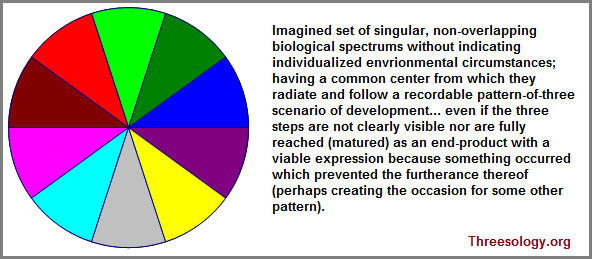
My usage of a triangular color spectrum in describing the Universe will stop short of attempting to explain the totality of events which occurred
in terms of the larger cosmological scene. I will deviate from this course and jump into providing another color spectrum of Earth's development,
thereby excluding many of the events from the Big Bang to the development of the Earth's existence. Hence, I will place the spectrum of Earth's
development inside the spectrum of the Milky Way Galaxy within the Spectrum of the Cosmos, as an initial offering of a more elaborate focus of
"threes" development on Earth:
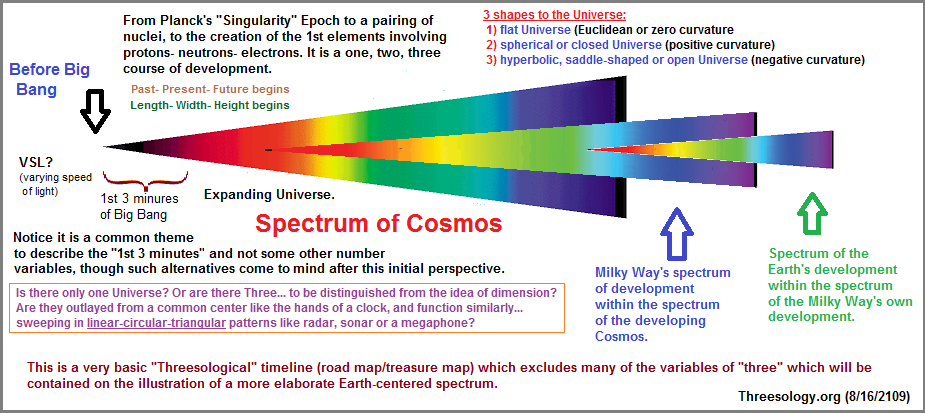
In an investigation of the Threes phenomena it is imperative that the researcher provide sources for all materials (wherever and whenever possible).
Indeed, intentional acts of plagiarism or slight will eventually be found out and may cause considerable discredit to otherwise sincere efforts. Therefore,
let me begin with my own rendition of the Creative Commons Idea, placed into a
"Threesological" frame of reference which required a bit of updating through reinterpretation and elaboration:
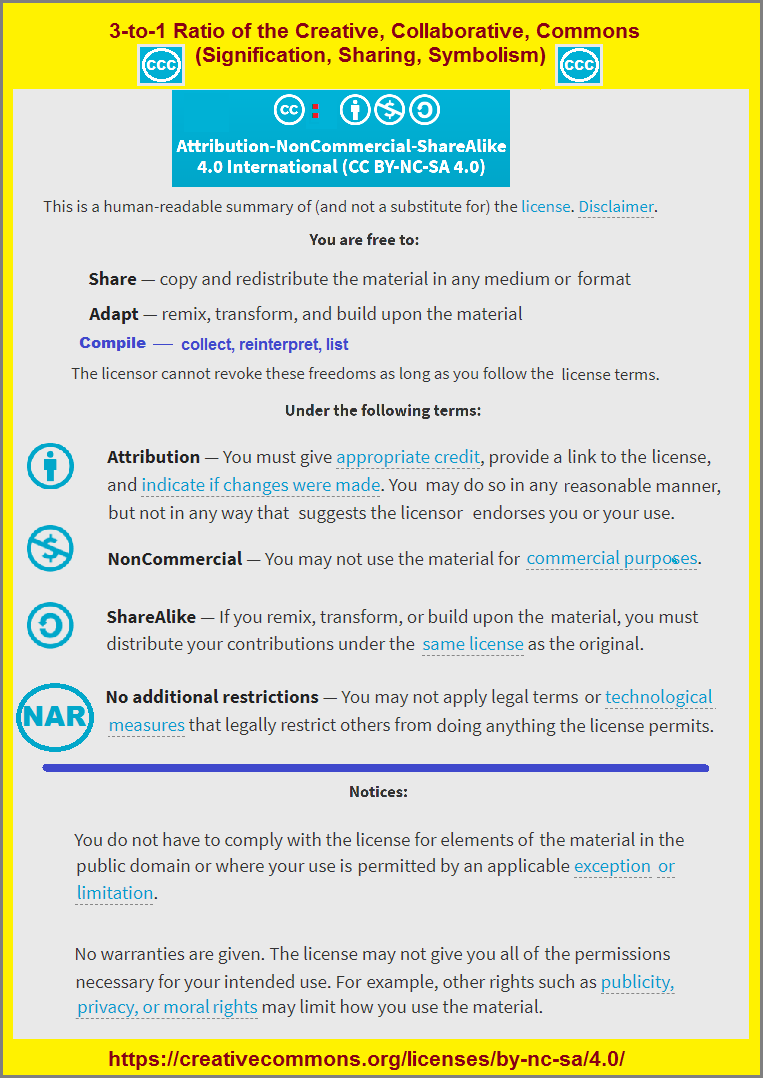
In addition to the foregoing singular necessity involving the use of materials supplied by others in their respective interests, orientations, and
applications, let me point out three others:
- Make a lot of notes of various different patterns which an accumulation thereof forces an attempted categorization(s). Some patterns will be more
easily "translatable" into your specific research criteria than others on an individual basis, while others may require two or more examples to provide
clarity.
- Provide a lot of sketches as examples since one picture can be worth a thousand words just as one word can be worth a thousand pictures; whether they were
created by others or those which are independently/originally constructed by yourself or an assistant ... or re-constructed from the information provided by
others.
- Write a lot of journaled reports, so that one's thinking processes can be re-viewed by oneself, contemporary researchers, and those who will come in the
distant years ahead.
Origination date: Tuesday, June 25, 2019... 4:41 AM
Initial Posting: Saturday, August 31st, 2019... 11:22 AM
Updated Posting:Tuesday, January 17th, 2023... 12:00 AM
Your Questions, Comments or
Additional Information are welcomed:
Herb O. Buckland
herbobuckland@hotmail.com








